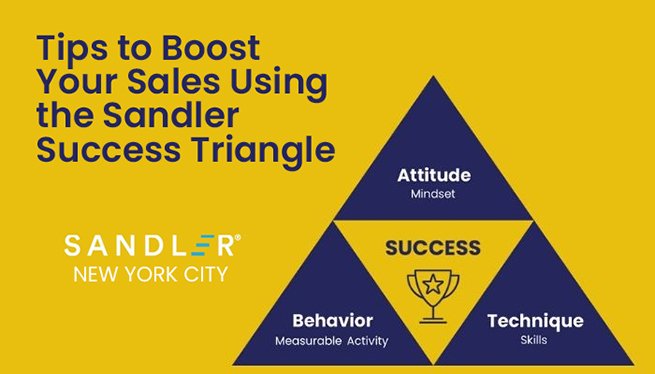Success in sales is a blend of both artistry and strategy, and the Sandler Success Triangle simplifies this by focusing on three key elements: Behavior, Attitude, and Technique. This practical framework helps sales professionals improve performance by identifying strengths and areas for growth.
More than just a concept, the Sandler Success Triangle offers a clear roadmap for achieving consistent, sustainable success. By mastering these interconnected elements, salespeople can sharpen their skills, maintain the right mindset, and develop productive behaviors that drive long-term results.
The Role of Behavior in Sales Success
Behavior, the first corner of the Sandler Success Triangle, is all about action and discipline. It encompasses the daily habits and routines that drive sales success, such as setting goals, planning strategies, and executing them with precision. Effective sales behavior is measurable and consistent, forming the backbone of a successful sales career.
Sales behavior is not static; it requires continuous refinement and adaptation to changing market conditions. Successful salespeople are those who can adapt their behavior to meet the demands of the market while maintaining a disciplined approach. This adaptability is crucial in a competitive sales environment, where only those with a proactive and disciplined behavior thrive.
Moreover, behavior in sales is closely linked to accountability. Sales professionals who take ownership of their actions and results are better positioned to achieve their goals. By cultivating a mindset of accountability, salespeople can ensure that their behaviors align with their objectives, leading to greater success.
Shaping a Winning Attitude for Sales
Attitude, the second component of the Sandler Success Triangle, is the internal engine that drives a salesperson's motivation and resilience. It refers to the beliefs, mindset, and perceptions that influence how salespeople view themselves, their company, and their market. A positive attitude can transform challenges into opportunities and setbacks into learning experiences.
A winning sales attitude is characterized by a mindset of possibility rather than limitation. Sales professionals with a positive attitude are more likely to engage with customers, build relationships, and close deals. This mindset fuels their motivation and empowers them to overcome obstacles with confidence and determination.
However, maintaining a positive attitude is not always easy, especially in the face of rejection or failure. Salespeople need to develop resilience and emotional intelligence to navigate the ups and downs of the sales process. By cultivating a strong, positive attitude, they can maintain their motivation and stay focused on their goals, even in challenging times.
Techniques that Elevate Sales Performance
The third element of the Sandler Success Triangle, Technique, involves the specific skills and strategies employed during sales interactions. These include questioning techniques, presentation styles, and closing tactics. Mastering these techniques is essential for sales professionals to effectively communicate value and persuade prospects.
Sales techniques are not one-size-fits-all; they need to be tailored to the unique needs and preferences of each prospect. Successful salespeople are those who can adapt their techniques to different situations and personalities, ensuring that their message resonates with their audience. This adaptability is a key factor in achieving sales success.
Furthermore, sales techniques should be continually refined and updated to reflect best practices and industry trends. By staying informed and honing their skills, sales professionals can maintain a competitive edge and elevate their performance. This commitment to continuous improvement is what sets top salespeople apart from the rest.
Interconnection of the Success Triangle Elements
The true power of the Sandler Success Triangle lies in the interconnection of its three elements: Behavior, Attitude, and Technique. These components do not exist in isolation; they are deeply intertwined, and each one influences the others. For example, a positive attitude can enhance sales behavior, while effective techniques can reinforce confidence and motivation.
This interconnectedness means that sales professionals need to develop all three elements simultaneously to achieve optimal performance. Neglecting one aspect can undermine the effectiveness of the others, leading to subpar results. By striving for balance and harmony among Behavior, Attitude, and Technique, salespeople can create a solid foundation for success.
The holistic nature of the Sandler Success Triangle emphasizes that sales success is not just about acquiring skills or adopting a positive mindset. It requires a comprehensive approach that integrates all aspects of the sales process. This synergy is what enables sales professionals to achieve consistent and sustainable results.
Using the Success Triangle as a Diagnostic Tool
One of the most valuable applications of the Sandler Success Triangle is its use as a diagnostic tool. Sales professionals can leverage this model to identify strengths and weaknesses in their sales approach. By analyzing each element of the triangle, they can pinpoint areas for improvement and develop targeted strategies to enhance their performance.
For instance, if a salesperson is not achieving the desired level of success, they can assess whether their behavior is aligned with their goals, if their attitude is positive and resilient, or if their techniques are effective. This diagnostic approach enables salespeople to make informed decisions and implement changes that drive results.
Conversely, when salespeople experience success, the Sandler Success Triangle can help them understand the factors contributing to their achievements. By recognizing what works well, they can replicate successful strategies and build on their strengths. This self-awareness is crucial for continuous growth and development in a competitive sales environment.
In conclusion, the Sandler Success Triangle offers a powerful framework for mastering sales. By focusing on Behavior, Attitude, and Technique, sales professionals can transform their approach and achieve unparalleled success. Whether used as a guide for personal development or a diagnostic tool for performance enhancement, this model provides the insights needed to thrive in the ever-evolving world of sales.






